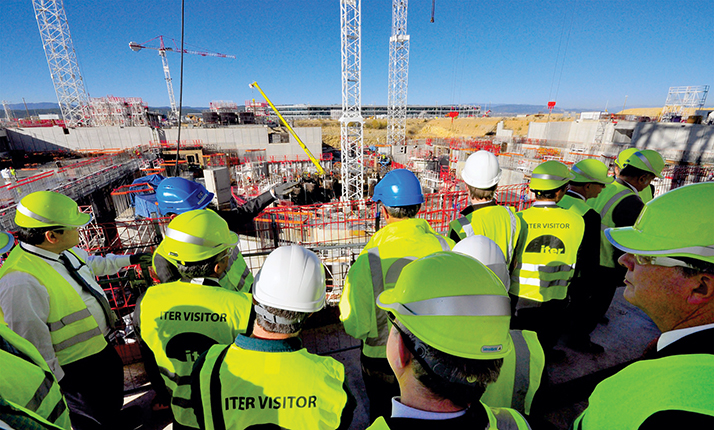ITER cost and schedule still not pinned down
DOI: 10.1063/PT.3.3049
The governing board of the world’s flagship fusion project has put off the release of a new cost and schedule estimate until June 2016, after the seven members decided to conduct an independent review of the ITER project management’s assessment.
At a mid-November meeting at the project site in Cadarache, France, the ITER Council received a new baseline estimate endorsed by ITER director general Bernard Bigot, which both he and the council declined to make public. The last official baseline, prepared in 2008, put completion of the mammoth project in 2019, at an estimated cost of €13 billion ($13.8 billion). But officials have acknowledged that the date will slip by several years and the cost will grow.

Delegates to the ITER council meeting in mid-November take a break to tour the ITER construction site, where pouring has begun on the concrete shielding that will completely surround the machine.
ITER ORGANIZATION

Bigot says he presented to the council multiple baseline scenarios, ranging from a best technically achievable schedule to one in which resources are kept to what the partners have currently agreed to contribute. “The ITER members need to go back to their budget authorities and to their political leaders to decide if we could meet the best technically achievable schedule or postpone a little more because we don’t have the resources. Before, we had a schedule but the resources were not clearly identified. Now we have all the ingredients to make a decision,” he says.
“Until we have the independent review, the council does not believe it is appropriate to start bandying about answers,” says Robert Iotti, the outgoing chair of the council. He would have been surprised had the council members not wanted to carry out their own assessment. “When there is an intensive effort where the estimate of every activity is provided by the people who have a vested interest in that activity—both the duration of that activity and the staff necessary to carry it out—you want to make sure that the estimate is vetted by having people with experience in that area saying, ‘Yes, you are right.’ ”
According to Iotti, biases might be introduced by those performing the work who want more resources than they actually need for a given activity. Similarly, the duration of that activity could be estimated to be longer or shorter than what is really necessary, either to give those carrying out the work more margin or to suggest that the performer can finish faster than is feasible.
A committee of experts appointed by the council will conduct the review. Their work is expected to begin in January, says Iotti, who stepped down in December. As a first-of-a-kind project, “all one can do is come up with a date that people feel is realistic, that’s achievable, and the risks are quantifiable in some fashion,” he says. The project’s international nature also creates risks, he adds. For example, components must fit together precisely despite being manufactured by multiple nations.
Extra funding approved
Bigot, who came to his post last March (see Physics Today, May 2015, page 21
Edmund Synakowski, associate director of the Office of Fusion Energy Sciences at the Department of Energy, says the US requested the independent review. “The US made clear, as we have consistently, that strong project performance is necessary for continued support,” he says.
Citing escalating costs, Senators Lamar Alexander (R-TN) and Dianne Feinstein (D-CA)—the chair and ranking minority member of the Senate appropriations subcommittee that funds DOE—have called for the US to withdraw from the project. A spokesperson for Alexander said he was too busy to comment but pointed to the committee-passed 2016 appropriations bill, which would deny the $150 million DOE requested for ITER. Feinstein’s office didn’t return a call. The House-passed counterpart bill would fully fund the DOE request. The two bills had yet to be reconciled as Physics Today went to press.
With the exception of the European Union, which as host pays 45% of ITER’s cost, the US and the other partners each contribute 9%, mostly in the form of in-kind components. “The US is sharing 9% of the cost, and they will get 100% of the knowledge from the results. It’s not such a bad deal,” notes Bigot.
The other partners in ITER are China, India, Japan, Russia, and South Korea.
More about the Authors
David Kramer. dkramer@aip.org




